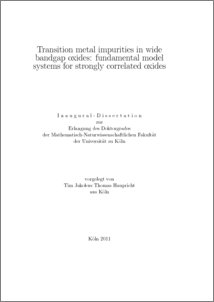Haupricht, Tim Jakobus Thomas
(2011).
Transition metal impurities in wide bandgap oxides: fundamental model systems for strongly correlated oxides.
PhD thesis, Universität zu Köln.

![[img]](https://kups.ub.uni-koeln.de/style/images/fileicons/application_pdf.png)  Preview |
|
PDF
Dissertation_Haupricht.pdf
- Published Version
Download (6MB)
|
Abstract
Most of the modern electronic devices are still based on the electrical properties of metals and semiconductors. Yet, the transition metal oxides show a variety of spectacular physical effects like, e.g., high-temperature superconductivity, the giant or tunnel magneto resistance, spin-polarized transport,
metal to insulator transitions, or multiferroic order. If ways could be found to make use of these phenomena, one could obtain devices with unprecedented functionalities. This, however, requires a profound understanding of the electronic structure of these compounds. Electron-electron correlations are very important here, thereby requiring a more sophisticated theoretical ansatz. An effective first order approach to take these correlation effects into account is to neglect the translational symmetry of the real crystal and to describe the electronic structure in a local single-site impurity model. This is done for example in the so-called configuration-interaction cluster calculations where the system is reduced to a single ion and its ligands, and also, at least for the correlations, in dynamical mean-field theory (DMFT). The underlying idea is that the ground state and near ground state properties
as well as the excitation spectra can be described on an equal footing as far as the many body aspects are concerned. It is not always easy, however, to judge about the applicability of the results for the real bulk systems. An experimental test is highly desired.
In this thesis we have, therefore, set out to study the electronic structure of selected transition metal impurities in oxides using photoemission (PES) and x-ray absorption spectroscopy (XAS). We have simulated our experimental data using a single-site cluster model and compare the results to the respective bulk systems. We found that transition metal impurities in oxides are fundamental model systems to study the electronic structure of strongly correlated oxides. A detailed study of their electronic structure yields essential information on the importance of local and non-local interactions in the associated bulk compounds and even more complicated materials.
| Item Type: |
Thesis
(PhD thesis)
|
| Translated abstract: |
| Abstract | Language |
|---|
| Die Funktionsweise moderner elektronischer Geräte basiert noch immer weitestgehend auf den elektronischen Eigenschaften von einfachen Metallen und Halbleitern. Übergangsmetalloxide hingegen weisen eine Vielzahl spektakulärer physikalischer Eigenschaften auf. So zeigen Sie z.B. Hochtemperatursupraleitung, den Riesen- oder Tunnelmagnetwiderstand, Spinpolarisierten Transport, Metall-Isolator Übergänge oder multiferroische Ordnung. Die technische Nutzung dieser Phänomene würde einen Zugang zu Geräten mit nie dagewesenen Eigenschaften ermöglichen. Diese allerdings erfordert ein tiefgehendes Verständnis der elektronischen Struktur dieser Verbindungen. Elektron-Elektron Wechselwirkungen sind hier sehr ausgeprägt und erfordern eine anspruchsvollere und detailliertere theoretische Behandlung. In einem weit verbreiteten und sehr erfolgreichen Ansatz zur Berücksichtigung dieser Korrelationseffekte wird die Translationssymmetrie eines realen Kristalls vollkommen vernachlässigt. Stattdessen wird die lokale elektronische Struktur einer einzigen isolierten Störstelle beschrieben. Diesen Ansatz verfolgen sog. configuration-interaction Clusterrechnungen, in denen der Festkörper auf ein einzelnes Ion nebst den dazugehörigen Liganden reduziert wird. Die zugrunde liegende Idee ist, dass hier Grundzustands- und Nahgrundzustandseigenschaften sowie Anregungsspektren im Hinblick auf Korrelationseffekte gleichberechtigt behandelt werden können. Auch eine der am weitesten fortgeschrittenen Methoden der theoretischen Festkörperphysik, die dynamische Mean-Field Theorie (DMFT), basiert auf diesem Ansatz. Trotzdem ist es oft nicht leicht zu beurteilen, wie gut die Ergebnisse
und Modellparameter auf reale, ausgedehnte Systeme übertragbar sind. Ein experimenteller Test wäre daher sehr wünschenswert.
Diese Arbeit beschäftigt sich aus diesem Grund mit der Untersuchung der elektronischen Struktur von Übergangsmetall-Störstellen in Oxiden mittels Photoemissions- (PES) und Röntgenabsorptionsspektroskopie (XAS). Die gewonnenen experimentellen Daten wurden im Rahmen von Clusterrechnungen simuliert, und die Ergebnisse mit den zugehörigen Volumensystemen verglichen. Es wird gezeigt, dass Übergangsmetall-Störstellen in Oxiden als fundamentale Modellsysteme zur Untersuchung der elektronischen Struktur stark korrelierter Oxide dienen können. Ihre detaillierte Untersuchung liefert essentielle Informationen über den Einfluss lokaler und nicht-lokaler Wechselwirkungen in den zugehörigen Volumensystemen oder weitaus komplizierteren Verbindungen. | German |
|
| Creators: |
| Creators | Email | ORCID | ORCID Put Code |
|---|
| Haupricht, Tim Jakobus Thomas | tim@haupricht.de | UNSPECIFIED | UNSPECIFIED |
|
| URN: |
urn:nbn:de:hbz:38-44296 |
| Date: |
2011 |
| Language: |
English |
| Faculty: |
Faculty of Mathematics and Natural Sciences |
| Divisions: |
Faculty of Mathematics and Natural Sciences > Department of Physics > Institute of Physics II |
| Subjects: |
Physics |
| Uncontrolled Keywords: |
| Keywords | Language |
|---|
| photoemission spectroscopy; PES; x-ray absorption spectroscopy; XAS; cluster calculations; NiO; FeO; MnO; V2O3; synchrotron radiation | English |
|
| Date of oral exam: |
3 February 2011 |
| Referee: |
| Name | Academic Title |
|---|
| Tjeng, L. H. | Prof. Dr. | | Michely, T. | Prof. Dr. |
|
| Refereed: |
Yes |
| URI: |
http://kups.ub.uni-koeln.de/id/eprint/4429 |
Downloads per month over past year
Export
Actions (login required)
 |
View Item |


